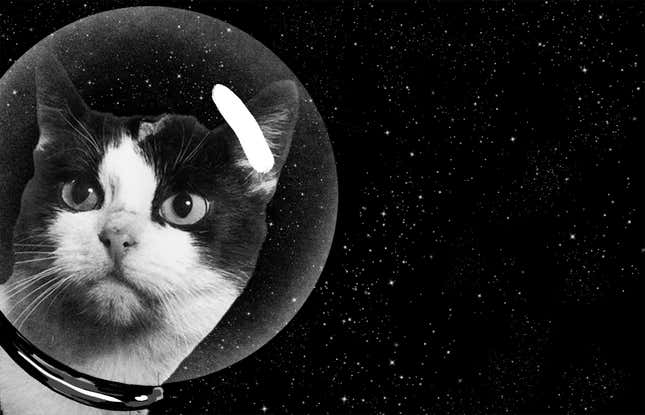
On October 18th, 1963, the Centre national d’études in France was set to send a small cat named Félix into space. After lagging behind its Soviet and American competitors, France was eager to stake its claim in the space race—with cats, for some reason. But on launch day, the mischievous little beast went missing—and an accidental heroine stepped in to take his place. Her name was Félicette.
From the streets of Paris, this tuxedo kitty—nicknamed “Astrocat”—would reach heights never achieved by feline kind. On October 24th, 1963, Félicette jetted 130 miles above Earth on a liquid-fueled French Véronique AG1 rocket, soaring high above the Algerian Sahara Desert. She returned just fifteen minutes later, already a decorated heroine for her nation.
After her landing, French scientists at the Education Center of Aviation and Medical Research (CERMA) studied Félicette’s brain waves to see if she had changed at all since her voyage. While not much is known about their findings—or about Félicette’s eventual fate—the CERMA said she had made “a valuable contribution to research.”
Unfortunately, Félicette’s story has been lost in the sands of time; A victim of our puptriarchal society that favors the achievements of dogs above all others. But France’s place in the overall space race—or lack thereof—could explain her erasure.
“I think it may be a matter of how history played out,” space historian and editor of the space history site collectSPACE Robert Pearlman told Gizmodo. “The effort that led to launching humans into space—and then ultimately, to the moon—was the space race between the United States and the Russians.”
The pioneering efforts of brave pups, monkeys and other animals paved the way for humans in the US-Russia space race to the moon. Scientists used animals as test subjects to see how a lack of gravity would impact them, and in effect, humans. If animals could survive the harsh conditions of space, so could we. At least that was the idea.

“Laika the [Soviet] dog led directly to Yuri Gagarin becoming the first human in space, which led to Alexey Leonov becoming human to spacewalk,” Pearlman said. “Monkeys Able and Miss Baker led to the first American flights that took heroes like John Glenn and Alan Shepard into space.”
While France does have its own formidable space program, Pearlman said the French ultimately did not pursue sending humans into space on their nation’s own rockets. That could explain Félicette’s relative mysteriousness.
“[France] is a partner through the European Space Agency and directly connected to NASA and the ISS, but French astronauts have typically launched on Russian or American rockets,” he said. “So Félicette doesn’t have a path to that larger history, [unlike American or Soviet animals].”
Though some animals, like mice, are still sent into space, society has largely shifted away from testing the effects of spaceflight on domesticated animals. The next time we’ll see cats in space is likely when humans are living in space.
“I don’t know if we’ll ever see cats or dogs fly again, at least in the short term,” Pearlman said. “We’ve moved beyond having to test on animals, to learn about how the human body would react in space—we’ve sent humans out into space and we’ve sent them up there for longer than a year. Their role in that sense has passed.”

“Until the point that we see families sent into space for tourist or transportation activities, I think at that point we might look at how to transport our pets,” Pearlman said.
Though Pearlman doesn’t have cats or dogs—though he did admit to being “more of a cat person”—he says Félicette “has a special place in his history book.”
By keeping her story alive, we pay our rightful respects to the brave stray cat who reached heights most of us never will. Besides, we want to be on good terms with cats when they inevitably take over Elon Musk’s martian colony.
“A Martian cat,” Pearlman pondered. “That would be interesting.”